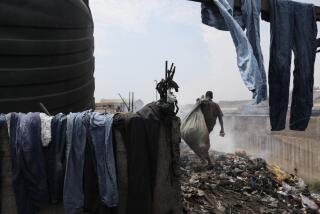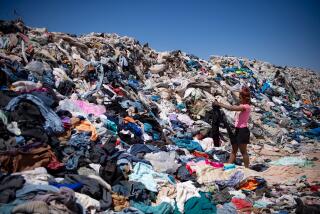Export Success Triggers Talk of U.S. Quotas : Textiles Help Lift Bangladesh From Poverty
- Share via
Impoverished Bangladesh, once described by Henry Kissinger as an international basket case, has rapidly expanded its textile exports over the past few years, only to draw protests from the United States, its major market.
In talks with U.S. textile negotiators here in late July, Bangladesh officials argued that their South Asian nation--the second-poorest country in the world with an average per capita income of $150 a year--needs to increase apparel exports to speed the development that will lift it from the morass of poverty.
Sixth-Largest Supplier
Bangladesh’s textile exports started from a low base: Its 1983 shipments to the United States of 2.1 million garments ranked it far below the major clothing suppliers of the world--Taiwan, Hong Kong, China and South Korea--which together hold 65% of the U.S. import market.
As a result, even though its clothing exports have grown more than 135% a year since 1983, its overseas sales totaled just $170 million in 1985 compared to $5.6 billion for Hong Kong, $3.4 billion for Korea, $3 billion for Taiwan and $2 billion for China.
Nonetheless, during the first half of this year, Bangladesh emerged as the sixth-largest supplier of clothing to the United States, shipping 50 million garments to this country. “We have become an important supplier by now,” said Commerce Secretary A. B. M. Ghulam Mostafa.
But its success has proved to be a mixed blessing for Bangladesh. Although its sales amounted to just 3% of all U.S. apparel imports during that period, the rapid growth attracted the attention of monitors from the domestic industry and U.S. textile negotiators.
“We never saw those rapid increases here before except in the case of China” a few years ago, said Ronald Sorini, deputy textile negotiator for the Office of the U.S. Trade Representative.
Bangladesh’s clash with U.S. quota limits illustrates the global conflict between the industrialized nations of Europe, the United States and Japan, which have domestic textile and clothing industries that they are trying to protect, and the low-wage nations of Asia, Africa and Latin America that want to increase their overseas textile and apparel sales to promote growth and prosperity.
Way Up From Poverty
U.S. negotiators are under added pressure from domestic manufacturers and their allies in organized labor, who are pressing a quota bill that would limit import growth in 185 categories of textiles and clothing to 1% a year for 10 years. The bill, which President Reagan has promised to veto, as he did with similar but more stringent legislation last year, is likely to come up in the House soon after Congress returns from its summer recess.
Poor countries like Bangladesh, however, see the emergence of an export-oriented textile and apparel industry as a major step out of poverty because it could start an industrialization process that could lead to greater development. This is the road followed by the newly industrialized countries of the Pacific Rim--Taiwan, South Korea and Hong Kong--that have become the development models for poorer Third World countries because of their rapid economic growth and their success in shifting into more sophisticated manufacturing, such as steel, autos and consumer electronics.
These countries, in fact, played a role in starting the textile industry in Bangladesh. As the textile quotas on their home countries became filled and additional U.S., European and Japanese restrictions loomed, clothing manufacturers in those countries began looking to new low-wage areas to locate factories. It doesn’t take much to start a clothing factory--just a few sewing machines for the simplest kind of garments.
The Far Eastern investors went first to Sri Lanka and then to the tiny island nation of the Maldives, also in South Asia. When the United States placed those countries’ exports under quotas, the investors moved to Bangladesh.
They were accompanied by American buyers who placed orders for flannel shirts, a simple, inexpensive garment to make. The foreign investors supplied the cloth, the thread, the buttons and the instruction, and in 1983 a total of 1.5 million flannel shirts flowed from Bangladesh factories to stores in the United States.
Most of the workers were women recruited from rural areas of Bangladesh who moved into the capital city of Dhaka and the port city of Chittagong, where most of the factories are located.
Mostafa, the Bangladesh official, recalled that the foreign teachers were amazed at how easily the new workers took to the trade. But weaving is a long and honorable tradition among women in Bangladesh, which produces some of the finest handmade textile products in Asia. (When Bangladesh was part of British India, the English colonialists broke the fingers of women there to stop them from weaving cloth and to force the people to buy products from the English mills.)
Now, Mostafa said, Bangladesh’s clothing industry is largely locally owned, financed by the savings of retired army officers, university professors and civil servants, and consists of some 600 factories employing about 200,000 workers who earn less than $50 a month. As low as that pay is, it is four times the per capita income for Bangladesh as reported by the World Bank.
The clothing factories, furthermore, now produce more complex garments, exporting products in 35 categories.
“We have diversified so that we will not create problems in the United States,” said Mostafa, who was here to take part in July’s textile negotiations.
Traditional Products Losing
“For very little investment,” he continued, “we have gotten a high return in terms of employment. What is more important, this has the potential of giving birth to other industries”--making the buttons, cardboard stiffeners, thread, fasteners and fabrics needed to make clothing.
The increase in clothing exports comes as Bangladesh’s traditional products--animal hides and skins, jute and tea--are not selling well in international markets.
As a result of its spurt in clothing sales, Bangladesh had $1 billion in export earnings in the fiscal year that ended last June, 24% above the 1986 level.
But Herman Starobin, research director for the International Ladies’ Garment Workers Union, takes issue with the program of boosting development through clothing exports. “It raises some very serious questions about American policies toward less developed countries and the whole concept of export-led growth,” he said.
In congressional testimony and an interview, Starobin said that the Bangladesh factory owners are being “ripped off” by their Western customers, who pay as little as $2.25 for a shirt that they then sell in this country for $16. The factory owners, in turn, exploit the workers with low wages and substandard working conditions, he said.
He pointed out that during negotiations here and in Dhaka, Bangladesh factory owners and government officials have pressed for special consideration because of the country’s poverty.
More to Read
Sign up for Essential California
The most important California stories and recommendations in your inbox every morning.
You may occasionally receive promotional content from the Los Angeles Times.










